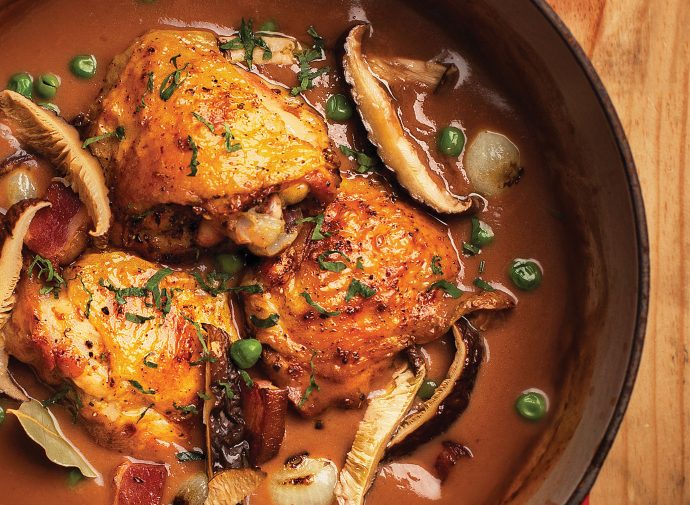I’ve written about this classic bistro dish in an earlier issue of the Cook’s Gazette. Traditionally prepared, it’s often a disappointment, with a thin acidic sauce and overcooked chicken. To correct this, Elizabeth David, in her book French Country Cooking (1951), gives the unorthodox suggestion of first creating a braising liquid by simmering one quart of strong unsalted chicken stock with wine and aromatics until reduced by half. Homemade stock makes all the difference here.
I’ve refined the process further by using only the tastiest, juiciest cut, the thighs. Using one part of the chicken also ensures all pieces are done at the same time. It’s an improvement over fishing around in the simmering stock to pick out the pieces as soon as they’re finished cooking, or ending up with either undercooked legs or overcooked breasts.
I chose dried shiitake mushrooms over fresh to add an even greater depth of flavor. The dried shiitakes must be re-hydrated before using. For the equivalent of one pound of fresh mushrooms, cover about 3 ounces of dried mushrooms with room temperature water and hold them down with a plate that fits over the mushrooms but inside the bowl to keep them submerged for at least 30 minutes. Lift them out of the soaking liquid and rinse the mushrooms to remove any grit. It’s worth it to strain the soaking water through a paper towel or coffee filter. You can add this strained liquid to the coq au vin or freeze it—it’s a flavor enhancer for many sauces and stews.
Coq au vin is great with mashed potatoes or French bread and a salad that contains some bitter greens. Maybe a bite of something chocolate for dessert and you have a classic bistro meal.
Ingredients
Braising Liquid
1-quart strong homemade unsalted chicken stock
1 bottle red wine (something with body that you would also be pleased to drink with the finished dish)
2 tbl tomato paste
3 cloves garlic
several branches thyme
bay leaf
Coq au Vin
3 pounds chicken thighs, bone in and skin on
4 oz bacon, cut into lardon. Don’t use bacon that is heavily smoked, or it will overwhelm the other flavors in the dish
3 oz dried shiitake mushrooms, rehydrated, rinsed thoroughly, stemmed, and sliced thin. You can always use a pound of fresh mushrooms if you prefer.
½ lb. fresh or frozen pearl onions. If unavailable, use a large Spanish onion, finely chopped.
¼ cup minced parsley, for garnish.
Optional
1/3 cup fresh or frozen green peas, added to the simmering sauce just before serving.
Optional Liaison
If you want to thicken the braising liquid, you have several choices:
Beurre Manié: 3 tbl flour kneaded with 3 tbl soft butter, whisked into the sauce a tablespoon at a time to finish the dish. Simmer for a few moments before serving.
Wondra Flour (pre-cooked flour): Use 2 to 4 tbl Wondra flour to every 3 cups of liquid. Dissolve the starch in a minimum amount of water, sherry, or port. Whisk in into the simmering broth and cook for 5 minutes or so before serving.
Instructions
Rehydrate the dried mushrooms or use fresh white button or cremini mushrooms. Cut the mushrooms into slices.
Pour yourself a glass of wine and then put the rest in a saucepan with the chicken stock, tomato paste, garlic, thyme, and bay leaf. Simmer until the liquid is reduced by half and then strain.
In a sauté pan, render the fat from the bacon lardon. Reserve the bacon and sauté the mushrooms and onion in this fat until they pick up some color. Put mushrooms, onion, and bacon together and set aside.
Brown the chicken. Often the cook is instructed to do this in a cast iron skillet or heavy sauté pan. However, I find it a lot easier to do on a sheet pan in a hot oven.
Preheat the oven to 450°F. Line up the thighs on a sheet pan. You want to remove the chicken from the oven when the skin is golden and the meat is halfway done, around 15 minutes. It’s optional whether you want to use the skin in the final dish. It has lots of flavor but does get a flabby texture after simmering the chicken. I leave it in.
Put the pre-cooked chicken and the reduced sauce base into a heavy-lidded casserole and simmer covered for about 15 minutes. Add the bacon/mushroom/onion mixture and cook for another 15 minutes. If you want, thicken the sauce with one of the liaisons. Complete the dish by checking the seasoning and, at the last minute, adding the minced fresh parsley and optional green peas.
If you have time, prepare the coq au vin a day or two before you plan to serve it, holding back on the liaison and optional peas. The next day, remove any fat that’s congealed on the top. Gently re-warm the dish to a simmer. If desired, thicken the juices with a liaison, and add the peas and parsley at the last minute.

